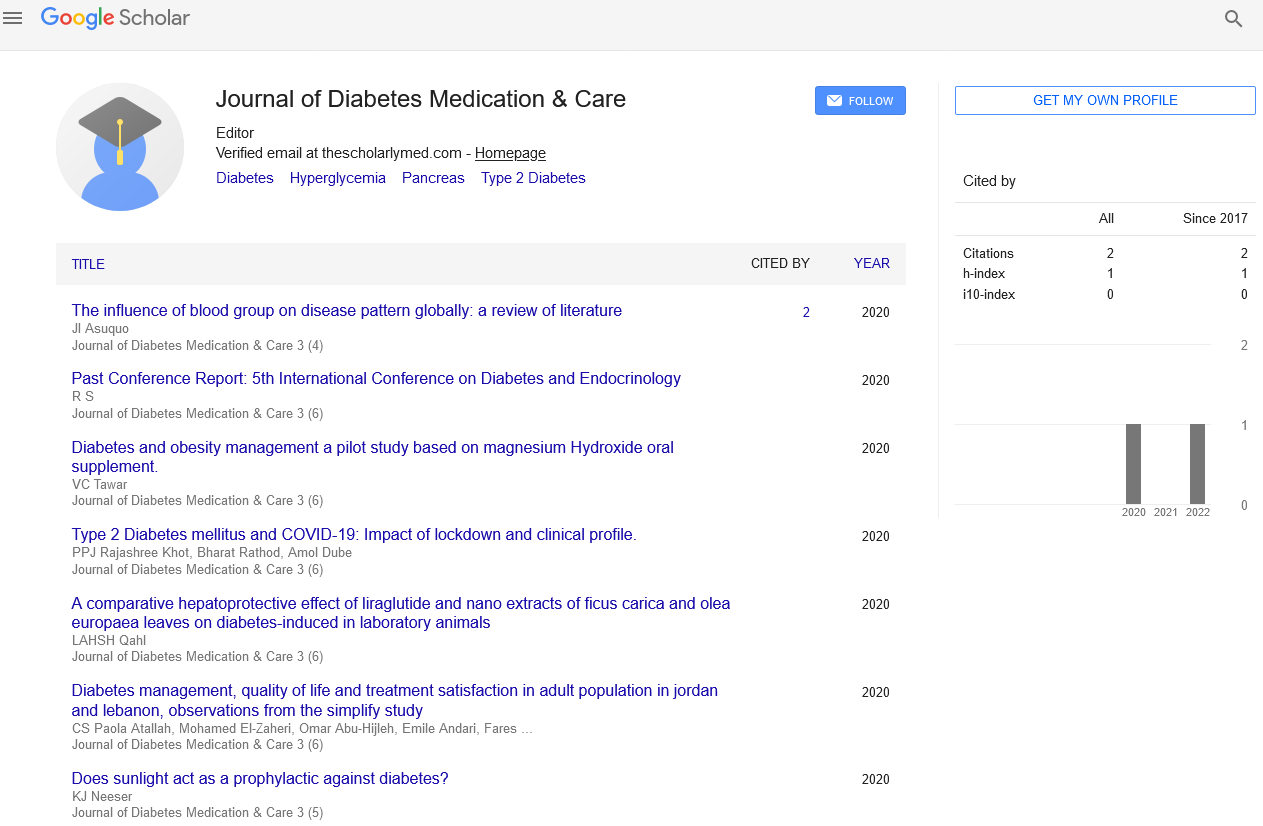Opinion Article - Journal of Diabetes Medication & Care (2024) Volume 7, Issue 5
Novel Biomarkers in Diabetes Management: Paving the Way for Precision Medicine
- Corresponding Author:
- Nikolas Sochein
Department of Endocrinology and Metabolism, University of Buenos Aires, Buenos Aires, Argentina
E-mail: nisocho@dtu.dk
Received: 13-Sep-2024, Manuscript No. JDMC-24-148361; Editor assigned: 16-Sep-2024, PreQC No. JDMC-24-148361 (PQ); Reviewed: 30-Sep-2024, QC No. JDMC-24-148361; Revised: 21-Oct-2024, Manuscript No. JDMC-24-148361 (R); Published: 28-Oct-2024, DOI: 10.37532/JDMC.2024.7(5).278-280
Introduction
Diabetes is a complex, multifaceted disease affecting millions worldwide. Managing diabetes effectively requires a comprehensive understanding of its underlying mechanisms, individual patient profiles, and potential complications. Traditionally, management strategies have relied on conventional biomarkers, such as blood glucose levels and HbA1c, to assess glycemic control and inform treatment decisions. However, with advancements in biotechnology and molecular biology, novel biomarkers are emerging that could revolutionize diabetes management. These biomarkers promise to enhance early detection, personalize treatment plans, and improve long-term outcomes. This article explores the significance of novel biomarkers in diabetes management, their mechanisms, and their potential impact on clinical practice.
Description
Understanding diabetes and its challenges
Diabetes is primarily classified into Type 1 Diabetes (T1D) and Type 2 Diabetes (T2D). T1D is an autoimmune condition characterized by the destruction of insulin producing beta cells in the pancreas, while T2D involves insulin resistance and often has a strong lifestyle component.
Despite advancements in treatment options, many patients still struggle to achieve optimal glycemic control. Traditional markers like fasting glucose and HbA1c provide valuable information, but they have limitations. For instance, HbA1c reflects average blood glucose levels over a period of time but does not account for daily fluctuations. Additionally, its interpretation can be affected by factors such as hemoglobin variants and anemia.
Novel biomarkers offer the potential to address these limitations, providing insights into disease mechanisms, predicting complications, and tailoring treatment approaches to individual needs.
Emerging novel biomarkers in diabetes management
MicroRNAs: MicroRNAs (miRNAs) are small, non-coding RNA molecules that play a significant role in gene regulation. Recent research has highlighted their potential as biomarkers in diabetes management.
Mechanism: miRNAs are involved in various metabolic processes, including insulin signaling, glucose metabolism, and inflammation. Dysregulation of specific miRNAs has been linked to the development of insulin resistance and beta cell dysfunction.
Clinical application: Several studies have identified miRNAs, such as miR-29 and miR-126, as potential biomarkers for diagnosing T2D and predicting complications. Measuring circulating levels of these miRNAs could provide insights into disease progression and help clinicians tailor treatment strategies accordingly.
Glycated proteins beyond HbA1c
While HbA1c remains a standard marker for glycemic control, researchers are exploring other glycated proteins that may offer additional insights into glucose metabolism.
Fructosamine: This biomarker reflects average blood glucose levels over the preceding 2-3 weeks, providing a shorter-term assessment compared to HbA1c. It may be particularly useful in patients with hemoglobinopathies or other conditions that interfere with HbA1c accuracy.
Glycated albumin: Glycated albumin levels provide information on glycemic control over 2-3 weeks. Studies suggest that this biomarker may correlate well with postprandial glucose levels, making it a valuable tool for monitoring glucose fluctuations and adjusting treatment.
Inflammatory markers
Chronic low grade inflammation plays a crucial role in the development and progression of diabetes, particularly T2D. Researchers are investigating inflammatory markers that could serve as novel biomarkers for diabetes management.
C-Reactive Protein (CRP): Elevated CRP levels have been associated with insulin resistance and increased cardiovascular risk in diabetic patients. Monitoring CRP levels could help identify patients at higher risk for complications, enabling proactive interventions.
Interleukins: Specific interleukins, such as IL-6 and IL-1β, are involved in inflammatory pathways linked to insulin resistance. Assessing these markers could provide insights into the inflammatory state of patients with diabetes, aiding in the development of targeted therapies.
Adipokines: Adipokines are bioactive molecules secreted by adipose tissue that play a role in glucose metabolism and insulin sensitivity. Research has identified several adipokines that may serve as biomarkers in diabetes management.
Leptin: This hormone regulates energy balance and is often elevated in obesity. Increased leptin levels have been associated with insulin resistance, making it a potential marker for assessing metabolic health in diabetic patients.
Adiponectin: Unlike leptin, adiponectin has anti-inflammatory properties and enhances insulin sensitivity. Lower levels of adiponectin have been linked to T2D and its complications. Monitoring adiponectin levels could provide insights into a patient’s metabolic status and risk of progression.
Gut microbiome derived metabolites: Emerging research suggests that the gut microbiome may play a significant role in metabolic health and diabetes management. Specific metabolites produced by gut bacteria have shown promise as biomarkers.
Short-Chain Fatty Acids (SCFAs): SCFAs, produced through the fermentation of dietary fiber by gut bacteria, have been linked to improved insulin sensitivity and anti-inflammatory effects. Measuring levels of SCFAs in the bloodstream may provide insights into the gut microbiome’s role in diabetes.
Bile acids: Bile acids have been shown to influence glucose metabolism and insulin sensitivity. Dysregulation of bile acid metabolism has been implicated in T2D. Investigating bile acid profiles could offer valuable information for personalized diabetes management.
Applications of novel biomarkers in clinical practice
Early detection and diagnosis: Novel biomarkers can enhance early detection of diabetes and prediabetes, allowing for timely interventions. For instance, measuring miRNAs or specific glycated proteins may enable healthcare providers to identify individuals at risk for developing diabetes long before traditional diagnostic criteria are met.
Personalized treatment strategies: Biomarkers can guide personalized treatment approaches by providing insights into individual metabolic profiles. For example, assessing levels of inflammatory markers or adipokines may help clinicians tailor interventions based on a patient’s unique pathophysiology, optimizing therapy and improving outcomes.
Monitoring disease progression and complications: Regular monitoring of novel biomarkers can provide valuable information on disease progression and the risk of complications. For example, tracking inflammatory markers or miRNA levels may enable clinicians to identify patients at risk for cardiovascular events or other diabetes related complications, facilitating proactive management strategies.
Evaluating treatment efficacy: Novel biomarkers can also be used to assess the efficacy of diabetes treatments. For instance, measuring circulating glycated proteins or inflammatory markers can provide insights into how well a patient is responding to therapy, enabling timely adjustments to treatment plans.
Challenges and future directions
Despite the promise of novel biomarkers in diabetes management, several challenges remain:
Validation: Many novel biomarkers require extensive validation in diverse populations before they can be widely adopted in clinical practice. Research must establish their reliability, reproducibility, and clinical utility.
Standardization: Developing standardized protocols for biomarker measurement is essential for ensuring consistent results across different laboratories and settings.
Integration into clinical practice: Incorporating novel biomarkers into routine clinical practice requires changes in guidelines and training for healthcare providers. Education about the significance of these biomarkers is crucial for widespread adoption.
Cost and accessibility: The development and implementation of novel biomarker tests must be cost-effective and accessible to patients to ensure equitable healthcare delivery.
Conclusion
In novel biomarkers are paving the way for a more personalized and effective approach to diabetes management. By enhancing early detection, guiding treatment decisions, and monitoring disease progression, these biomarkers have the potential to improve patient outcomes and quality of life. As research continues to evolve, addressing the challenges associated with biomarker validation and implementation will be critical for realizing their full potential in clinical practice. The future of diabetes management lies in harnessing the power of these innovative biomarkers, ultimately leading to a more tailored and effective approach to this complex disease.

